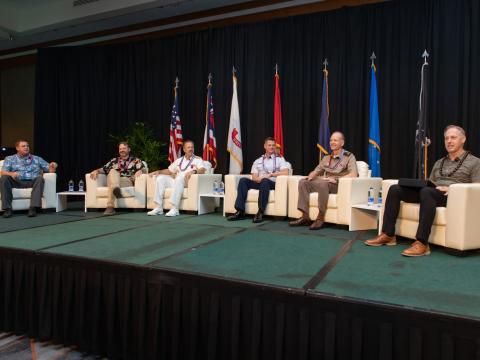On Point: Q&A With Maj. Gen. Jeth Rey
Maj. Gen. Jeth B. Rey is the director of the Network Cross-Functional Team within Army Futures Command, focusing on integrating and modernizing the Army’s network. He previously served as the director of Command and Control, Communications and Computer Systems, J-6, U.S. Central Command.
What has been the biggest challenge to network modernization so far?
We continue to unify and modernize the network in support of the Secretary of the Army’s objective to ensure the Army becomes more datacentric. The network will always face challenges with the rapid evolution of commercial technology and how we can adapt it to military requirements and scale it appropriately across different elements of the Army. Based on recent observations, the primary challenges to achieving network modernization supporting the Army of 2030 are fielding velocity—the pace of delivering new equipment to the force—and alignment of capabilities across echelons.
How do early lessons learned from the Russia-Ukraine war affect Army network modernization plans?
What we are seeing in Ukraine reinforces the need for secure communications and greater mobility and survivability. There is also great innovation occurring with our soldiers who are supporting operations in Europe. In May, I had the opportunity to travel to Germany with the program executive officer for Command, Control and Communications-Tactical and Department of Army headquarters personnel to visit U.S. Army Europe and Africa, 18th Airborne Corps, and 5th Corps. We gained a deeper understanding of fielded equipment and assessed innovation activities to inform network modernization way ahead, especially on a more datacentric approach.
What is the biggest challeng to coalition interoperability?
From a technical perspective, we need to shift away from mission partner networks that are theater-specific and rule-based to a true mission partner environment. We also have to ensure our policies are tailored to share particular sensor information and data and that we collaborate with our multinational partners to understand what information they are willing to share. The Mission Partner Environment (MPE) is how we will give commanders the ability to share information and exchange data at the speed of relevance with mission partners—across multiple releasable and classification levels without going through a cross-domain solution for every transaction. At Project Convergence 22 (PC22), we will experiment with MPE to enable data sharing, operational synchronization and integration across joint and multinational partners.
Which capabilities in the future capability sets excite you most?
I’m excited about tactical data fabric, which is a critical capability in support of datacentricity and joint all-domain command and control (JADC2). At PC21, the Army demonstrated how initial data fabric capabilities enable sensor-to-shooter linkages by ingesting data from multiple sources and joint systems. Since then, we have integrated data fabric into the Command Post Computing Environment program of record and continued DevSecOps to improve the capability for PC22. The PC22 tactical data fabric adds scale and expands from intel-fires integration to add cyberspace and logistics/sustainment capabilities. Going forward, the Army will work with U.S. Army Pacific on soldier touch points to continue to improve tactical data fabric for initial delivery in Capability Set (CS) 23 and further enhancements as part of CS25.
What will be the biggest network modernization accomplishment over the next year?
Delivery of CS23 will be an important milestone. CS23 aligns more than 40 systems—from soldier radios and satellite terminals to mission command software and network operations tools—into a system of systems that increases network resiliency, capacity and convergence. CS23 introduces high-throughput, low-latency satellite communications through commercial services and nontraditional orbits to provide additional communications options for commanders. It also increases integration of electronic warfare, intelligence, fires and sustainment capabilities into the network. As we field CS23, we continue to develop CS25, CS27 and beyond to incorporate solutions that enable the future network to be transport-agnostic, datacentric, and underpinned by modernized security architecture and cyber resiliency.



Comments